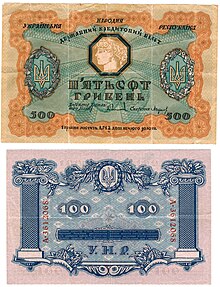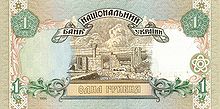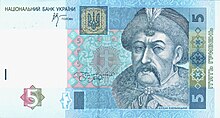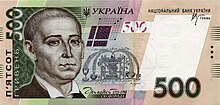Hryvnia
| Hryvnia | |
|---|---|
| Country: |
|
| Subdivision: | 100 Kopijok |
| ISO 4217 code : | UAH |
| Abbreviation: | ₴, грн (hrn.) |
|
Exchange rate : (29 Mar 2020) |
1 EUR = 31.401 UAH 1 CHF = 29.18 UAH |
The hryvnia ( Ukrainian гривня ; scientific transliteration: hryvnja ; pronunciation : [ ˈɦrɪu̯nʲɑ ]; nom. Plural hryvni , gen. Plural hryvnia , also called hryvnia ) has been the currency of Ukraine since the currency reform in September 1996 . The ISO code is UAH . The 100th part of a hryvnia is called Kopijka (Gen. pl. Kopijok ).
history
Already during the time of the Kievan Rus there was a universal monetary unit called the hryvnia / hryvnia , which corresponded to just under one pound of silver (400 g).
One theory says that the word "hryvnia" comes from the gold and / or silver jewelry that was worn around the neck (griwa, zagriwok). Smaller currency units were also used: Nogata ( bear or wolf ), Kuna ( mink or sable ), Wekscha ( squirrel ). The rule was: 1 hryvnia = 20 nogata = 25 kuna = 100 wekscha .
In the 11th century, the hryvnia was used as a unit of measurement. In the 12th century, a silver hryvnia weighed around 204 grams.
Later, the hryvnia was used to denote copper coins (2.5 or 3 kopijok), or hrywenik ( гривеник ) for a silver coin worth 10 kopijok. This traditional name was used until Soviet times.
In the turmoil after the October Revolution , in the Ukrainian People's Republic , which had been founded on Russian territory, the currency was initially called Karbovanets . After the merger with on the former Habsburg territory incurred West Ukrainian People's Republic on 22 January 1918, the Central Council decided on 1 March 1918, the introduction of a new currency: the hryvnia. It was divided into 100 units and was worth half a karbowanez '. The banknotes were printed in Berlin during 1918 . For the time being, Karbowanez continued to be issued, which then circulated at the same time as the hryvnia.
Issue of banknotes in chronological order:
- January 5, 1918: 100 Karbowanez
- April 6, 1918: 25 and 50 Karbowanez
- October 17, 1918: 10, 100 and 500 hryvnia
- October 1918: 1000 and 2000 hrywen
- August 1919: 10, 100, 250 and 1000 Karbowanez
- October 1919: 25 Karbowanez
After the annexation to the Soviet Union , the "Bolshevik Thousand" initially applied in the Ukraine, which, however, had a very bad course towards the Karbowanez. There were again currency reforms between 1922 and 1924, which first introduced the Soviet Chervonetz, then the Soviet Karbovanets and later finally the ruble , which was called Karbovanets in Ukrainian .
After the dissolution of the Soviet Union and the establishment of a new Ukrainian state in 1991, a transitional currency ( Coupon-Karbowanez / купоно-карбованець ) was introduced, which suffered from hyperinflation due to the economic crisis during this period. The mean annual exchange rate in 1992 was 135 coupons for one D-Mark , in 1995 there were 102,886 coupons for one D-Mark.
On August 25, 1996, President Leonid Kuchma proclaimed a currency reform that brought a new currency under the old name "Hryvnia" with it. The currency, which was put into circulation from September 2 to 16, 1996, is comparatively stable. Starting with an exchange rate of around 1.21 hrywen for one German mark, the average rate for one euro in 2000 was 5.03 hrywen. After that, the rate was loosely pegged to the US dollar for a long time . Between October and December 2008, the exchange rate deteriorated from around 6.5 to around 11 hrywen for one euro. Since the end of December 2008, the hryvnia should be pegged to the US dollar at a fixed rate of 7.7 to 1. In February 2014, the exchange rate was 9.42 hrywen for one US dollar. In the course of the political crisis in Ukraine in the first half of 2014, there was a massive drop in the rate of the Ukrainian currency. The current exchange rate from the hryvnia to the euro is around 30: 1.
Coins
Circulation coins are available in denominations of 1 hryvnia, as well as 1, 2, 5, 10, 25 and 50 Kopijok. The coins for 1 Kopijka and 2 Kopijki are no longer minted, but are still valid.
Modern banknotes
One hryvnia note
The front of the banknote shows the Grand Duke of Kiev , Vladimir I the Great ( Ukrainian Володимир Великий , * 960, † 1015). Grand Duke Vladimir I, illegitimate son of Grand Duke Svyatoslav I of the Rurikids family and the princely servant Maluscha, ruled the kingdom of Kiev between 980 and 1015 . Under his regiment, the empire expanded enormously and in 988 the Rus was Christianized . He owes his nickname the saint or the apostle to the latter event . In this way, the Ukraine historically ties in with the state tradition of the Kievan Rus , whose legacy is now shared by three East Slavic peoples - Russians , Ukrainians and Belarusians .
In contrast to its predecessor, the reverse of the new hryvnia note from 2004 shows the medieval Hrad (castle) of Vladimir I in Kiev . The back of the notes in the old design from 1992, 1994 and 1995 showed the ruins of Chersonese , an old Greek colony in the Crimea . Grand Duke Vladimir I conquered the city in 988 and was baptized here in a church. From Chersonese, Christianity spread through the Eastern Slavs .
In 2006, a note with the same images was introduced, but in the national colors of Ukraine.
Two hryvnia note
The brown note for two hryvnia replaced an older version in 2004. Both have a portrait of Yaroslav the Wise on the front and the Kiev Cathedral of St. Sophia on the back .
Five hryvnia note
The blue note for five hryvias from 2004 shows Bohdan Khmelnyzkyj on the front and the church of the village of Subotiv near Tschyhyryn on the back.
Ten hryvnia note
The red note for ten hrywen, dated 2004, depicts Ivan Masepa and the Kiev-Pechersk Lavra .
Twenty hryven note
On December 1, 2003, the National Bank of Ukraine introduced the new design of the 20 hryvnia note. Like its predecessors, the obverse shows the Ukrainian poet Iwan Franko (Ukrainian Іван Франко , born August 27, 1856, † May 28, 1916) from Eastern Galicia . The slopes of the Ukrainian Carpathians can be seen in the background . Along with Taras Shevchenko, Franko is one of the most important figures in Ukrainian literature and symbolizes western Ukraine. After him, the city of Stanislau was renamed Ivano-Frankivsk in 1962 , the same name the Ivano-Frankivsk Oblast bears .
A picture of the Lviv Opera House adorns the back of the banknote. In the foreground is the allegory of the Gloria (Ukrainian Слава , Polish Slava ), a winged female figure with a bent golden palm branch in both hands. This allegory crowns the tympanum of the opera house between the genius of drama (left) and the genius of music (right). The theater was built between 1897 and 1900 by the Lviv architect Zygmunt Gorgolewski and is one of the most beautiful in the Ukraine and in all of Eastern and Central Europe . In 1956 the theater was named after Iwan Franko. The theater has been named Solomija Kruschelnyzka since it was last renamed in 2000 .
Fifty hryvnia note
On the front is Mychajlo Hruschewskyj (Ukrainian Михайло Грушевський , born September 29, 1866, † November 25, 1934). Hruschewskyj was initially active as a professor of Eastern European history at the University of Kiev , since 1894 he was a professor of de facto Ukrainian history at the University of Lviv . In 1898 he began work on his monumental work History of Ukraine-Rus in Lviv , which he wrote until 1927. The work lists Ukrainian history up to the 1660s and is considered the basic conceptual work of Ukrainian historiography. During the Ukrainian Revolution 1917–1920, Hruschewskyj headed the Central Na Rada , the provisional political representation of the Ukrainian nation, and was therefore the first nominal head of state of the Ukrainian People's Republic . In the Soviet Union , Hruschewskyj was considered a bourgeois nationalist historian and the publication of his works was not allowed until 1989. On the new 50 hrywen note from 2004, Hruschewskyj is shown at a much younger age than on the old one from 1996.
A complete change was made in 2004 on the back of the note. This no longer shows the building of the Verkhovna Rada , the Ukrainian parliament, but the former Pedagogical Museum (so-called teachers' house ) in Kiev . The Central Na Rada met here from 1917 to 1918; today's parliament house of the Verkhovna Rada was only inaugurated in 1936. This is intended to create a better link with the historical personality on the front of the banknote. The picture is framed with the figures of a peasant woman and a worker, these motifs often appear on the hryvnia bills that were printed between 1918 and 1919 and are intended to indicate the social democratic orientation of the republic at that time.
One hundred hryven note
The front of the 100 hryven note shows the Ukrainian national poet Taras Shevchenko . The poet, who was born in serfdom and later bought out with the support of the Russian painter Karl Brjullow, still has a strong influence on the national consciousness of Ukrainians with his striving for freedom and suffering . In contrast to the old 100 hryven note from 1996, where Shevchenko was depicted in old age with a traditional Ukrainian hat made of lambskin, the new note from 2006 shows the poet in his younger years. The National Bank of Ukraine made this change at the request of several Shevchenko experts and historians. The new picture is an image of the most famous self-portrait of the poet, which he drew during the times of his greatest popularity. In the background of the Shevchenko picture is the face of Katharina , the heroine of the Shevchenko drama of the same name.
The reverse of the banknote has also been changed. While the design from 1996 showed the Kiev Cathedral of St. Sophia with the famous bell tower, now the Dnepr landscape with Tschernetscha Hora (German monk hill) can be seen. Tschernscha Hora, also called Tarasowa Hora (Taras Hill), is a hill on the Dneprufer near Kaniw and the final resting place of Taras Shevchenko . Shevchenko expressed the wish to be buried on the banks of the Dnieper in Ukraine in his poetic legacy ( Заповіт ) in 1845 . In the foreground there is also a blind Kobzar with a bandura and an accompanying boy. These mostly blind singers used to go from place to place like the medieval troubadours and sang their ballads from the glorious and liberal Cossack times . So Kobzar has also become a symbol of Ukrainian consciousness. Taras Shevchenko is often called the Great Kobzar. The picture on the back of the 100 hryvnia note is from one of his sketches.
A renewed version of the banknote was issued on March 9, 2015, but with the same motif.
Two hundred hryvnia note
The purple note for 200 hrywen with Lesja Ukrainka replaced an older version in 2007. On the back, parts of Lubarta Castle in Lutsk are shown.
Five hundred hryvnia note
The orange bill for 500 hrywen from 2006 is adorned with a portrait of Hryhorij Skoworoda , on the reverse the Mohyla Academy .
According to the rate on March 29, 2020, the 500 hryvnia note has the equivalent of EUR 15.92.
A thousand hryvnia note
The portrait of Volodymyr Vernadsky adorns the blue bill for 1000 hryvnia from 2019 . The reverse shows the National Academy of Sciences .
According to the rate on March 29, 2020, the 1000 hryvnia note has the equivalent of EUR 31.85.
Representation of the currency symbol
The symbol of the currency ![]() can be found in the Unicode standard at position U + 20B4: ₴ (only visible with suitable font).
can be found in the Unicode standard at position U + 20B4: ₴ (only visible with suitable font).
See also
Individual evidence
- ↑ Офіційний курc українського карбованця щодо іноземних валют (середній за період) 1992–1995 роки. (No longer available online.) In: National Bank of Ukraine. Archived from the original on October 22, 2008 ; Retrieved March 2, 2009 . Info: The archive link was inserted automatically and has not yet been checked. Please check the original and archive link according to the instructions and then remove this notice.
- ↑ Офіційний курс гривні щодо іноземних валют (середній за період). (No longer available online.) In: National Bank of Ukraine. Archived from the original on March 22, 2009 ; Retrieved March 2, 2009 . Info: The archive link was inserted automatically and has not yet been checked. Please check the original and archive link according to the instructions and then remove this notice.





















